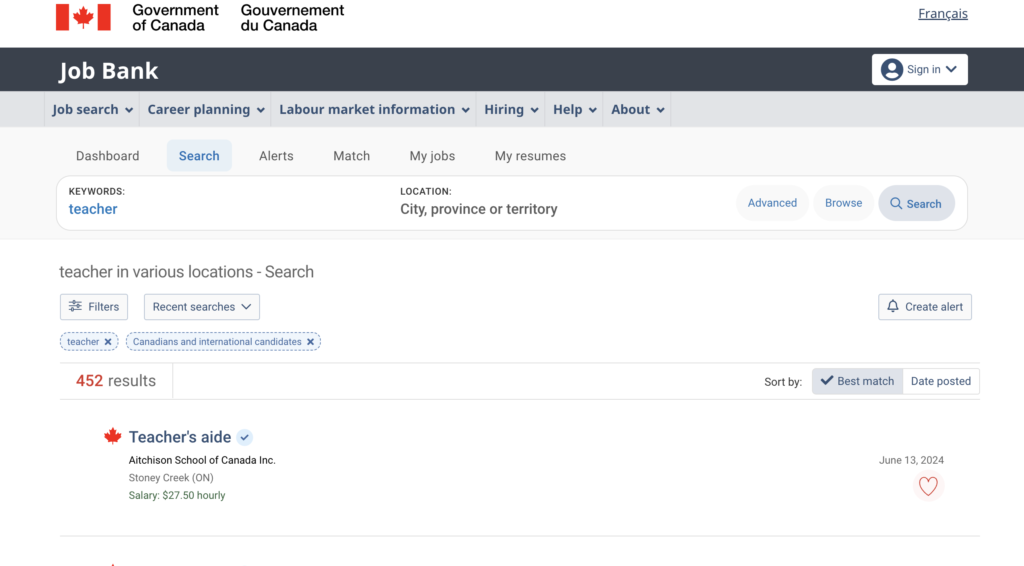Teaching in Canada Might Be Your Pathway. See How
The educational sector in Canada currently suffers from an ongoing skills shortage because of the country’s low birth rate and retiring population, so to solve this, Canada has opened its arms to skilled foreigners to teach in the country.
Teaching in Canada is a highly respected profession as the country’s education system is one of the best in the world due to reasons like curriculum and top-notch infrastructure.
So, if you have been looking forward to migrating to Canada, teaching might be a pathway.
Statistics To Remember
Canada’s Job Bank projects a significant number of teaching opportunities over the next decade. Here’s a breakdown of the projected job openings:
- Elementary School and Kindergarten Teachers: 121,000
- Secondary School Teachers: 52,100
- School Principals and Administrators: 11,000 (elementary and secondary education)
From these figures, we can see that there’s an opening for everyone in the teaching sector.

The Different Types of Teaching Jobs in Canada
1. Elementary and Kindergarten Teachers (NOC 41221)
Jobs in this sector include kindergarten teachers, supply teachers, primary school teachers, English as a second language elementary school teachers, special education teachers, French as a second language elementary school teachers, etc.
2. High School or Secondary School Teachers (NOC 41220)
The different job roles in this sector include biology teacher, English teacher, remedial teacher, adult-education teacher, French as a second language teacher, commerce teacher, vocational teacher, secondary school department head, etc.
3. School Principals and Administrators (NOC 40021)
This sector covers both elementary and high school. Job roles include school vice principal, chief superintendent, school principal, director of school for the hearing-impaired, superintendent of elementary education, board of education administrator, etc.
Immigration Programs for Foreign Teachers
The Federal Skilled Workers Program
This program is for people who have skills, work experience, and qualifications and are interested in working in Canada. If your application for this program is successful, you will be offered permanent resident status, but there are certain requirements that you must meet to qualify.
There is also the Federal Skilled Worker Express Entry Program which is a program that selects applicants based on their CRS (Comprehensive Ranking System) rather than their occupation. The CRS score is dependent on different factors like language proficiency, age, and education. Applicants can secure additional points if they have studied or worked in Canada if they have a job offer or a provincial nomination.
Provincial Nominee Programs (PNP)
In Canada, there are many provinces with PNPs which allows them to nominate candidates according to the current labor market needs. This program is best for applicants who know the specific province they want to practice teaching in Canada.
Depending on the province of your choice, you can either apply through the Federal Express Entry Program or simply apply directly.
Here are the different programs as obtained from the MDC Canada site.
- Alberta Immigrant Nominee Program (AINP)
- British Columbia Provincial Nominee Program (BC PNP)
- Manitoba Provincial Nominee Program (MPNP)
- New Brunswick Provincial Nominee Program (NW PNP)
- Newfoundland & Labrador Provincial Nominee Program (NL PNP)
- Northwest Territories Nominee Program (NTNP)
- Nova Scotia Provincial Nominee Program (NS PNP)
- Ontario Provincial Nominee Program (OINP)
- Prince Edward Island Provincial Nominee Program (PEI PNP)
- Saskatchewan Immigrant Nominee Program (SINP)
- Yukon Nominee Program (YNP)
- Atlantic Immigration Program (AIP)
This is a federal program that provides permanent residence in Canada’s Atlantic provinces to international students who studied in Canada and foreign skilled workers. Applicants may qualify for the AIP program if they have a minimum of 1,560 paid employment hours in the past 5 years.
Also, one will need to meet the requirements with the major one being having a job offer from any of the Atlantic provinces in Canada. Keep in mind that you can only get a teaching job after you get a license from the province.
Related: Move Abroad By Force
Application Process for Teaching in Canada
1. Eligibility
Before applying for teaching in Canada, you first need to check if you meet all the requirements. The IRCC has certain factors that they consider when it comes to applicants being eligible to travel.
They are:
- Age
- Natonality
- Family members
- Language Proficiency: Most provinces in Canada require applicants to prove their proficiency in English. This involves submitting language test results like IELTS. If you plan to practice teaching in Canada in Quebec or Francophone schools in other Canadian provinces, you have to prove your proficiency in French and English
- Job offer
- Education: If you did not study in Canada, you will need an ECA (Educational Credential Assessment) to check that your foreign degrees or diplomas are authentic and equivalent to a Canadian degree/diploma. For example, an equivalent of a bachelor’s or undergraduate degree in education and child development is required for kindergarten and elementary school teachers
Also, you must be licensed by a province before you can teach in Canada. This is a process that you can start before moving but it can take some time so once you choose your province of interest, apply to the teaching regulatory body there. Note that some jobs may not require you to have a certificate, Work experience, Income and proof of settlement funds. Lastly, you need to have completed the sexual abuse prevention program.
2. Choose a Suitable Immigration Program
Once you have confirmed your eligibility, the next thing for you to do is to choose the right immigration program. Canada has over 100 pathways to choose from but it is advisable to select from the ones explained above as they are ideal for teaching in Canada.
3. Online Application
After choosing a suitable immigration program, you can then create an immigration profile and apply online. Applying online streamlines the process and makes it easy for you to submit required documents and resubmit documents if the need arises.
Conclusion
So, there you have it. Your dreams of teaching in Canada can be actualized by following the steps above. Remember to ensure that you secure a teaching job before you move to Canada. You can do that by searching different job websites like LinkedIn, Indeed Canada, Job Bank Canada, and Workopolis.
For more information on teaching in Canada, check this website out.







